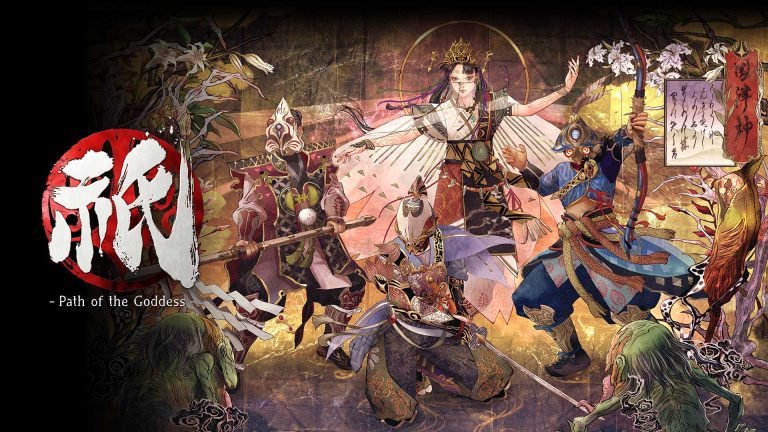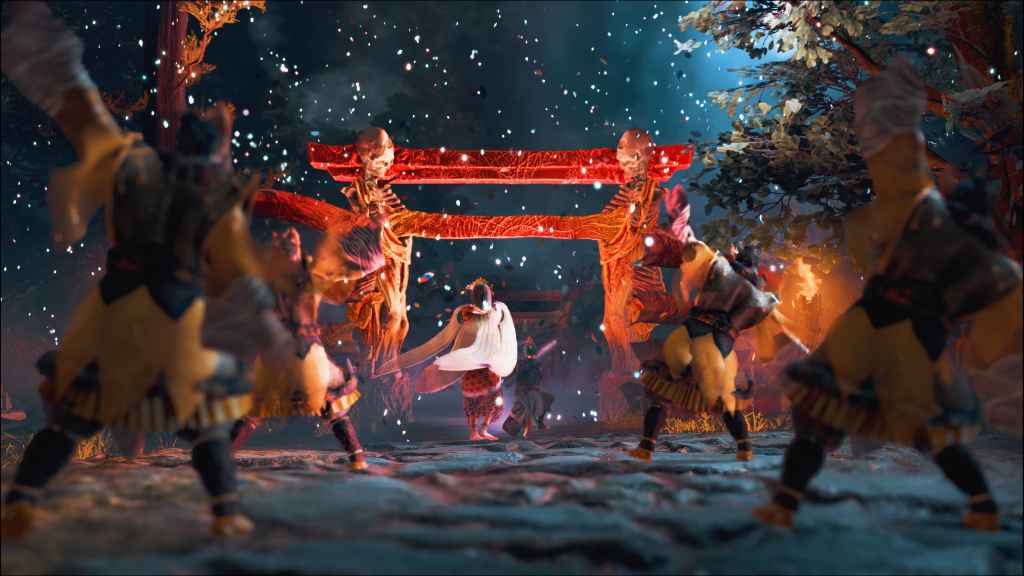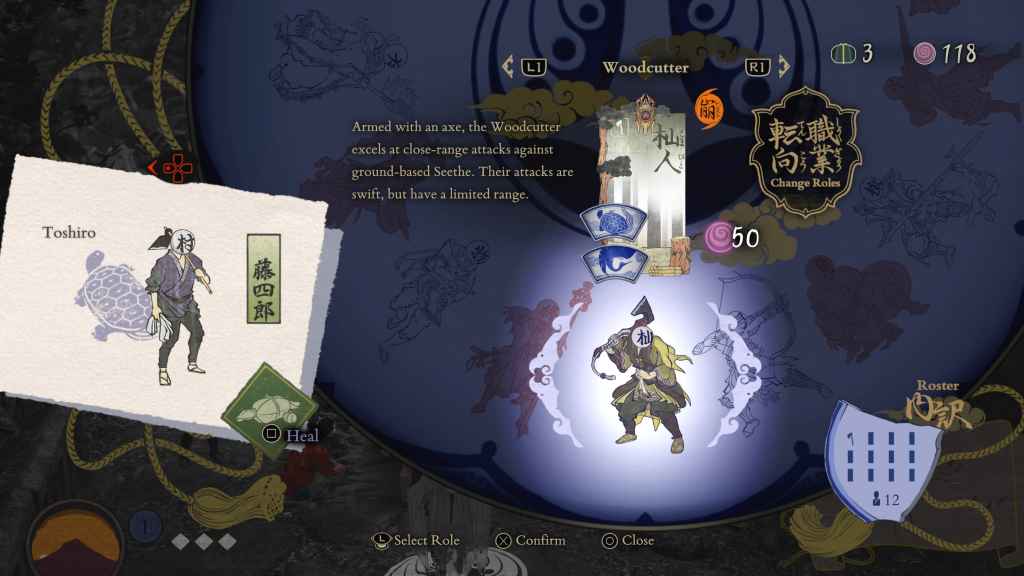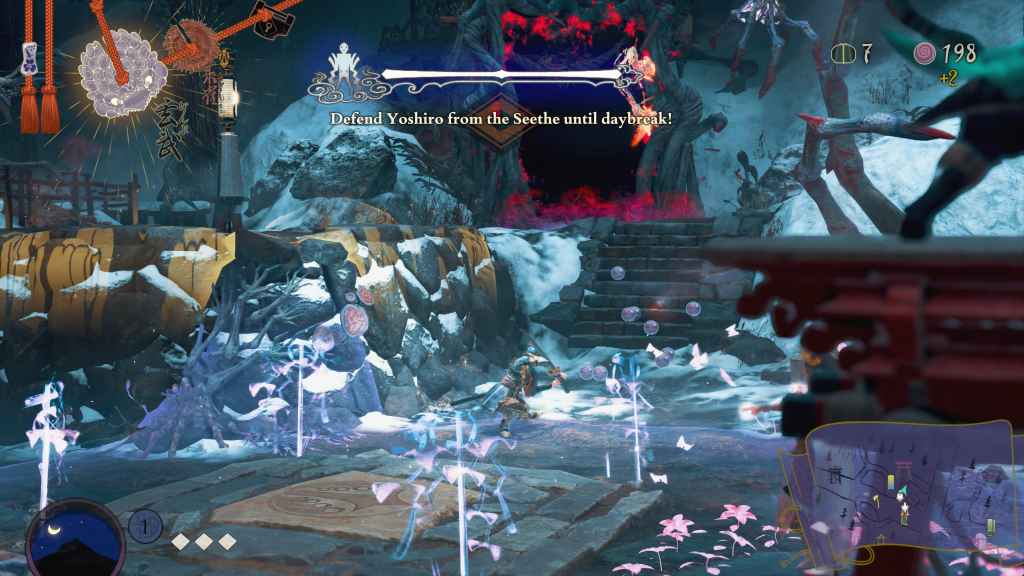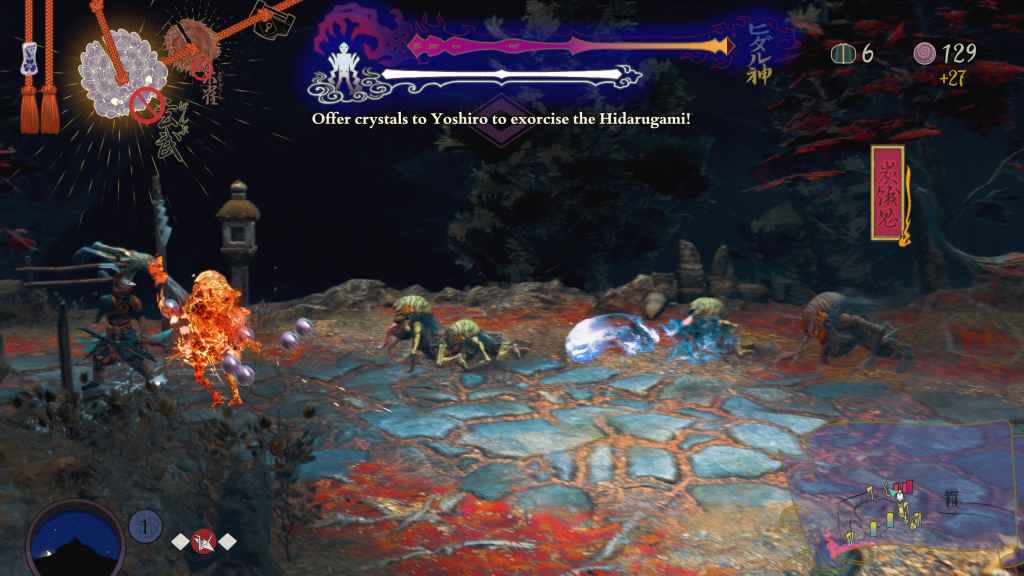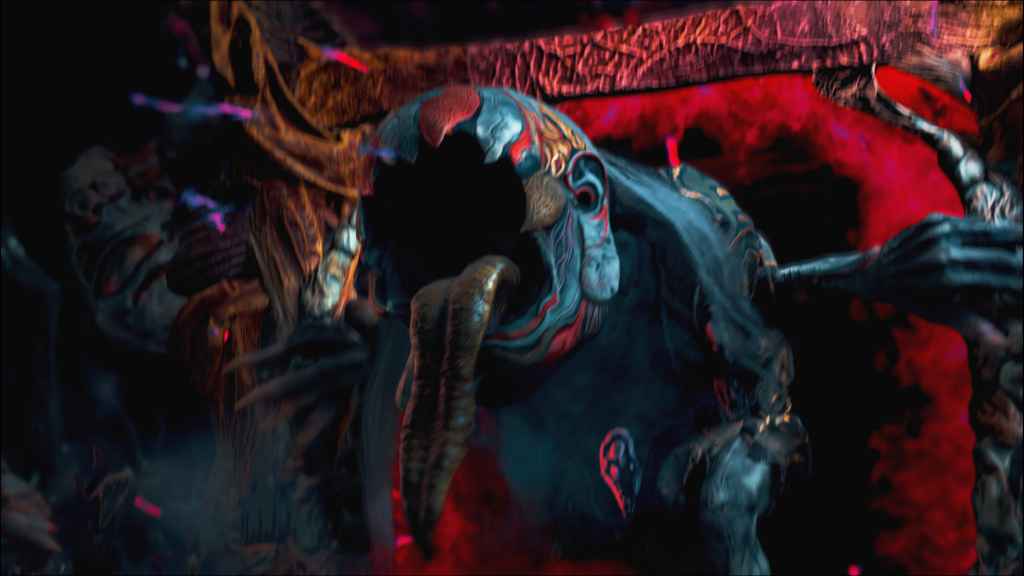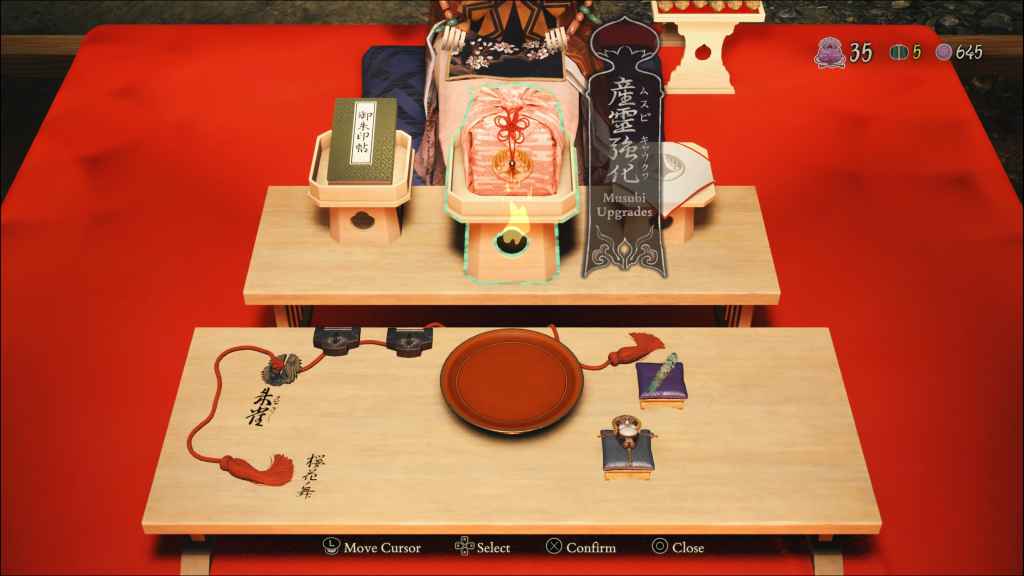Kunitsu-Gami: Path of the Goddess Review PS5 Review. There was a brief moment in the middle of my playthrough of Kunitsu-Gami: Path of the Goddess where dual protagonists Yoshiro and Soh were in their shared tent, and I saw a small animation of Yoshiro eating a sweet that I had put on the table. There was something in this small moment that brought the entire experience of the game so far into perspective and helped me to connect with an experience that I was struggling to understand.
Kunitsu-Gami: Path of the Goddess is an original IP from the creatives at Capcom and stands as an interesting fusion of the tower-defence and action-combat genre in the process. Where I initially feared that this fusion was misguided and far more flawed than expected, I eventually found that it found a steady pace that helped to open my eyes to the potential of this bold creative venture.
With a distinctive visual style and approach to storytelling, I eventually found myself embracing the uniqueness of Kunitsu-Gami: Path of the Goddess as it emerged as a shockingly robust strategy title, where I initially shrugged it off – and I’m glad I stuck with it.
Kunitsu-Gami: Path of the Goddess Review (PS5) – A Slow Burning Strategic Sensation
A Plot of Few Words
Kunitsu-Gami: Path of the Goddess is a title full of bold artistic choices that really manage to set it apart from the other IP in Capcom’s repertoire. Most notably, the lack of spoken dialogue. The vast majority of the narrative in Kunitsu-Gami is delivered non-verbally. Neither Soh or Yoshiro communicate in words, with each other or the villagers around them.
In an age obsessed with making quippy and memorable characters, the decision to have two almost completely silent protagonists was a change of pace that caught me off-guard. Despite a lack of words, this doesn’t take away from the overarching story and instead reminded me of titles like Ico and Shadow of the Colossus.
The relationship between Soh and Yoshiro forms the cornerstone of the experience in Kunitsu-Gami and I found myself being invested in a shockingly short amount of time. Their journey to cleanse the mountain of the defilement and the Seethe is an entertaining enough premise, brought together by a personal journey of servitude and self-sacrifice that has a tangible weight as you progress and is reflected in the gameplay itself.
An Exciting Fusion
Kunitsu-Gami: Path of the Goddess presents an exciting fusion of strategy and action combat to create an experience unlike anything presented to us by Capcom before. And while it takes some time for this system to come into its own, this investment is more than worth the admittedly decent amount of time it takes to get rolling.
Typical encounters are split into two halves, with both being pivotal to your success. Most missions task Soh with creating a path for Yoshiro to travel across to purify the demon gate at the end of it. The “spirit path” is created through the use of crystals that are gathered through removing defilement from the settlements you explore. Immediately, the core loop of gathering crystals to make a path is established.
This loop is complicated by the potential to recruit rescued villagers as soldiers to fight against the Seethe. Equipping your villagers with different roles costs the same crystals that you need to use to create the path, so priorities must be weighed. Day segments involve Soh exploring areas to gather crystals, rescue villagers and generally prepare for the Seethe onslaught that will inevitably arrive during the night.
When the Moon Rises
The primary objective of night missions is to protect Yoshiro from being damaged by the Seethe, indicated by a large health bar at the top of the screen. Combat in Kunitsu-Gami is a relatively simple system, that grows significantly over the course of the game. Soh has access to a relatively limited but versatile number of options that can easily carry you through the opening missions of the game without much need to invest in the villager units at your disposal. With a simple string of light and heavy attacks that can be linked together, it feels like a slightly slower-paced iteration of a character action game.
The early missions can feel like a drag when you can mindlessly and single-handedly keep Yoshiro safe from any threat – and I was worried that this would be true for the entire experience. Previews of the game indicated that your approach to the game could be ‘flexible’ and I was concerned that it meant that I could simply ignore the villagers and move on with just Soh.
This couldn’t be further from the truth.
Where Kunitsu-Gami: Path of the Goddess gives you ample time to get a handle on the basics and the general systems of the game, it wastes no time in ratcheting the difficulty up and introducing unique scenarios that force you to stretch your knowledge of the game and its systems.
These scenarios can range from static missions of tower-defence for an extended period, to missions that force you to rely completely on the use of villager units and contraptions to protect Yoshiro, while you recover and offer crystals to Yoshiro to aid her in a spirit form. And it was these missions that helped me to appreciate the synergy of all the mechanics at play here. There was a satisfaction that came from successfully constructing and effectively deploying an army of units to protect Yoshiro.
While these missions were a fun change of pace, I did find them to grind my progress to an almost halt while I tried to complete them. Your own interactions with the environment become exceptionally limited and almost totally reliant on NPCs that don’t exactly show much of their own initiative in high-stress scenarios.
You need to micromanage and babysit everything they do. This isn’t too much of a headache but I did occasionally find that enemies could slip into my base because they skirted the range of my units by a tiny margin. Where I could normally cover for these with Soh, certain missions make this an impossibility. Similarly, the requirements for beating these missions can turn them into chores – with some feeling like they last far too long.
These occasions are rare but are emblematic of greater pacing issues across the board that could be solved with just a bit of refinement. There was more than one occasion where Yoshiro ended a day cycle achingly close to the end of the path, before forcing me to sit through one more night and I couldn’t help but wish she moved just a bit faster. This generally became less pronounced over time but was a lingering part of the game that left me a bit frustrated.
Bosses Aplenty
After the majority of missions, there are singular boss encounters that pit Soh and a troupe of villagers against a beast in an isolated arena. Each boss demands a unique strategy, similar to the main missions, and most are exciting adrenaline-pumping challenges that reward quick thinking.
Quick thinking is emphasised to such a degree that you gain access to dedicated “attack” and “defend” commands for your villager comrades in order to protect Yoshiro against enemy attacks or to capitalise on a staggered boss.
Rather than feeling like enemies with larger health pools, bosses encourage creative thinking while allowing you to build on the strategies that you have developed so far, and are visual marvels in their own right.
These bosses draw upon classic Japanese mythological beasts as their primary source of inspiration and each is unique and offers a completely different approach to battle. Where some may be basically bigger enemies, others may take the form of almost platforming challenges, or being more focused on spreading your units out strategically. Each one presents exciting opportunities and things to learn.
A Quiet Moment
Kunitsu-Gami is also more than just a tower-defence game, there is an explicit focus on rebuilding the areas that you free from the defilement, once again making use of the villagers that you rescue. These rebuilding elements tie directly to the upgrade system of Kunitsu-Gami and feed back into the overarching narrative.
After finishing a level, you are able to revisit it and assign villagers to particular areas to rebuild it into a place for peace to return. Each of the repairs in an area takes a certain amount of villagers and a certain amount of time to complete, measured in stages. This encourages and incentivises you to return to areas and gain rewards, in Musubi upgrade points and story-related tiles, that offer insight into the greater world and character of Kunitsu-Gami, with major rewards for completely rebuilding settlements.
These bases allow you to upgrade your different unit types with Musubi points that you gather on missions, with a similar approach to flexibility here too. You can invest in different units and reallocate points as you see fit to ensure your favourites are able to excel. I found a use for every unit in the game and so having the ability to experiment was appreciated.
You can also invest in Soh’s abilities, with the opportunity to stagger enemies and expand on his ranged options on offer. Bizarrely, some abilities are locked behind a cost that relates to what I feel should be basic things. The ability to command villagers to tactically retreat and move around were all locked out until I unlocked the ability to upgrade Soh and these are the ones that help to elevate the combat to something strong.
You can also increase the amount of equippable accessories and special techniques for use during missions, further expanding your options. Exploring these options is vital to succeed as the difficulty steadily increases across the campaign.
A Spirited Spectacle
Bringing all these moving parts together in cohesion is a fantastically unique approach to the presentation that mixes elements of Capcom’s previous titles and creates a bold style. Floral and vivid explosions of colour – reminiscent of Okami – are mixed with heavy and grungy purples for the Defilement and the Seethe. There’s an uncanny insect-like nature to the enemies in this game that wouldn’t be out of place in one of Capcom’s survival horror series.
The same juxtaposition is found in the sound design of Kunitsu-Gami, quietness is used to amplify moments of peace, where a foreboding sound emerges as you move from day to night. As I scrambled to find the final few villagers before the night turned, the aggressive ambience really builds tension for the trial ahead.
These elements meld together with the story and gameplay to produce something that stands out in their impressive catalogue. Those familiar with Okami will see a lot to love in this return to Japanese folklore as a foundation, but there is a unique angle here that is a more than worthy attempt at a new IP.
Kunitsu-Gami: Path of the Goddess is due out on July 19 for PS5, PS4, PC, Xbox Series X/S, and Xbox One.
Review code kindly provided by publisher.
